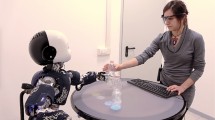Abstract
The success of social robots in achieving natural coexistence with humans depends on both their level of autonomy and their interactive abilities. Although a lot of robotic architectures have been suggested and many researchers have focused on human–robot interaction, a robotic architecture that can effectively combine interactivity and autonomy is still unavailable. This paper contributes to the research efforts toward this architecture in the following ways. First a theoretical analysis is provided that leads to the notion of co-evolution between the agent and its environment and with other agents as the condition needed to combine both autonomy and interactivity. The analysis also shows that the basic competencies needed to achieve the required level of autonomy and the envisioned level of interactivity are similar but not the same. Secondly nine specific requirements are then formalized that should be achieved by the architecture. Thirdly a robotic architecture that tries to achieve those requirements by utilizing two main theoretical hypothesis and several insights from social science, developmental psychology and neuroscience is detailed. Lastly two experiments with a humanoid robot and a simulated agent are reported to show the potential of the proposed architecture.






Similar content being viewed by others
References
Argyle M (2001) Bodily communication. Routledge, London
Birdwhistell RL (1970) Kinesics and context. University of Philadelphia Press, Philadelphia
Blumberg BM (1997) Old tricks, new dogs: ethology and interactive creatures. PhD thesis. MIT, Cambridge
Brooks RA (1991) Challenges for complete creature architectures. In: Meyer JA, Wilson SW (eds) From animals to animats. MIT, Cambridge, pp 434–443
Buchsbaum D (2004) Imitation and social learning for synthetic characters. PhD thesis. MIT, Cambridge
Castelfranchi C, Falcone R (2004) Founding autonomy: the dialectics between (social) environment and agent’s architecture and powers. Lect Notes Artif Intell 2969:40–54
Condon WS, Ogston WD (1966) Sound film analysis of normal and pathological behavior patterns. J Nerv Ment Dis 143:338–347
Davies M, Stone T (1995) Mental simulation. Blackwell, Oxford
Ishiguro H et al (1999) A robot architecture based on situated modules. In: IEEE/RSJ Conference on Intelligent Robots and Systems, vol 3, pp 1617–1624
Kendon A (1970) Movement coordination in social interaction: some examples considered. Acta Pyschol 32:1–25
Lee C (1999) Robust radial basis function neural networks. IEEE Trans Syst Man Cybern B 29(6):674–685
McDowall JJ (1978) Interactional synchrony: a reappraisal. J Pers Soc Psychol 36:963–975
Mohammad YFO, Nishida T (2006) Interactive perception for amplification of intended behavior in complex noisy environments. In: International workshop of Social Intelligence Design 2006 (SID2006), Osaka, pp 173–187
Mohammad YFO, Nishida T (2007) Intention through interaction: towards mutual intention in human–robot interactions. In: IEA/AIE 2007 conference, Kyoto, pp 114–124
Mohammad YFO, Nishida T (2008) Two layers action integration for HRI: action integration with attention focusing for interactive robots. Accepted for ICINCO 2008, Maderia
Mohammad Y et al (2007) Embodiment of knowledge into the interaction and physical domains using robots. In: ICCAS 2007, Seoul, pp 737–744
Murata A et al (1997) Object representation in the ventral premotor cortex (area F5) of the monkey. J Neurophysiol 78:2226–2230
Oberman LM et al (2007) EEG evidence for mirror neuron activity during the observation of human and robot actions: toward and analysis of the human qualities of interactive robots. Neurocomputing 70:2194–2203
Perez MC (2003) A proposal for a behavior-based control architecture with reinforcement learning for an autonomous underwater robot. PhD thesis. University of Girona, Girona
Sabbagh MA (2004) Understanding orbitofrontal contributions to theory-of-mind reasoning: implications for autism. Brain Cogn 55:209–219
Vogt P (2002) The physical symbol grounding problem. Cogn Syst Res 3:429–457
Ziemke T (1999) Does representation need reality. In: Rethinking grounding. Plenum, New York, pp 177–190
Author information
Authors and Affiliations
Corresponding author
Rights and permissions
About this article
Cite this article
Mohammad, Y., Nishida, T. Toward combining autonomy and interactivity for social robots. AI & Soc 24, 35–49 (2009). https://doi.org/10.1007/s00146-009-0196-3
Received:
Accepted:
Published:
Issue Date:
DOI: https://doi.org/10.1007/s00146-009-0196-3




